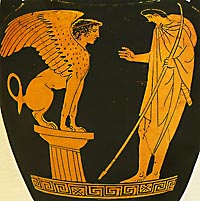In terms of both quantity and quality, red-figure pottery was
the Kerameikos' most important product. Not all the devastation
of the Persian wars could disrupt the continuity of the Archaic
tradition. The same painters and potters went on producing their
work. With choice of subject, and with expressive and technical
objectives, however, it was a different story: a new phase began
straight after 'the Persian business'. This period can be thought
of as the upper limit of early Classical vase-painting.
From the middle years of the 5th century up until 420 B.C.,
vase-painting went hand in hand with Athens' prosperity,
absorbing the influence of the sculptures of the Parthenon.
For red-figure pottery, this is the period usually
termed Classical.
Despite having the same name, we should not confuse it
with the Classical age as a whole, which runs from the
Persian Wars to Alexander the Great. Some of the most
important vase-painters of this period were working
simultaneously in the red-figure and the white ground
techniques. Towards the end of the 5th century, a
more and more obvious interest in form, composition and
decoration makes itself felt. This new trend is called
the Rich (or
Ornate) style. It lasted until about 390 B.C. Some of its
features were to survive throughout the first third of
the 4th century B.C. What one notices about Late Classical vase-painting
is 1) obvious falling-off in quality and execution, and
2) insistence on manneristic repetition of the same old
themes. And so red-figure ended on a downbeat note, in
about 320 B.C. |
 |
The major vase-painters - the ones we (sometimes) know the
actual names of because they signed their pots - were not the
only ones. Work was farmed out to apprentices, schools, groups
and circles. Sometimes there was a high degree of
'specialization'. We can speak of 'farming out' because there are
certain details, particularly anatomical, that we see steadily
being repeated - the painter's "fingerprint". This was
the method developed by Beazley as a variant on one
used by Morelli to study Renaissance art: Beazley adapted it to
the needs of ceramics. The appellation by which we now know a
vase-painter is seldom his real one. More often he
takes the name of the potter he worked with, since the latter did
sign his work. (Thus for example we speak of 'the Sotades
Painter'). In other cases the vase-painter's appellation
derives from the place where an important work of his was found
or is now kept. (Thus for example we speak of 'the Eretria
Painter' or 'the Munich 2413 Painter'). Lastly, a
large number of vase-painters have been called after the shape of
a particular pot or the scene on it. (Thus for example we speak
of 'the Phiale Painter' or 'the Talos Painter').




